Art X
Guppy: the Genealogy Table of the guppy strains
RUBRIEK: Guppy Kweek English Translation
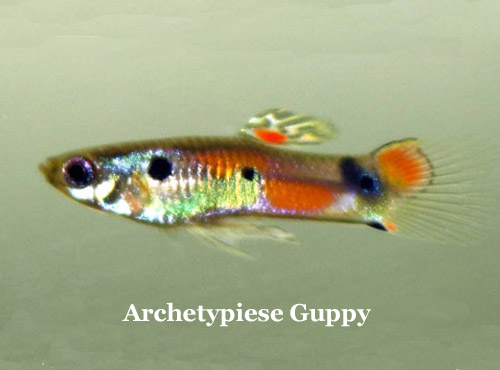
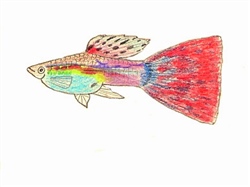

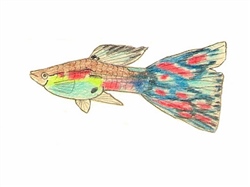

The guppy is an aquarium fish that has been bred for more than 100 years. But only the last 40 years have been well documented. That has its rea-sons. The first is an obvious one: the first books and magazines were main-ly provided with drawnings and colored prints; then followed by white-black photos. Those lasts did not do justice to the color splendor of the millionfish . The first color photos were also rather coarse in shades, so that it was actually mainly photography enthusiasts who could capture beautiful snapshots in color with good cameras. It took until the invention of digital photography, before "normal" photos of swimming guppies could be taken in their full splendor. And then again, those who have tried that know how difficult it still is. It is precisely at the time of printing that they rotate or swivel, so that they are taken rarely beautiful or complete.
Precisely for these reasons, in my youth I made drawings with colored pen-cils of the guppies I had bred. A monk-work that required a lot of patience and attention, but which provided me with documentation material that is unique and accurate to this day. All in all, the guppy strains of the first hour are known only from descriptions, or aproximative and often rudi-mentary sketches. The specimens of that time that were put in "strong water" have discolored over the years, and therefore do not give a good impression of the real colors of the time. The same applies to color photos taken of (freshly dead) fish or fish "on dry land": black, yellow and red dominate, while the iridescent colors blue and green largely "disappear". So they never "look" like a living and moving gup in water.
The actual genetics research on the guppy largely took place in these early years. At the same time, it was also the beginning of the genetics, and in the guppy with its great variability it was found to be a good study object to mark certain physical characteristics on certain gene pairs. New studies of the guppy are more concerned with how the phenotype of a population adapts to ecological reality: for example, the impact of predatory fish on the color of the males. The "science" has therefore not really studied the genetics of the gup strains that were subsequently bred by the breeders later.
And here is exactly arising an important problem : one continues with the mechanism to attribute each newly obtained form to a new gene, further mentioning that this probably or in most cases Y-bound, but not always. That is actually meaningless, because I have already noted in previous articles that gup females can be distinguished by their caudal fin shape and color, so that there is more a question of a blockage by the X chromosome of the colors on the body. The fact that the few most beautiful females I have grown in my career turned out to be sterile (due to a hormone dis-ruption) confirms this.
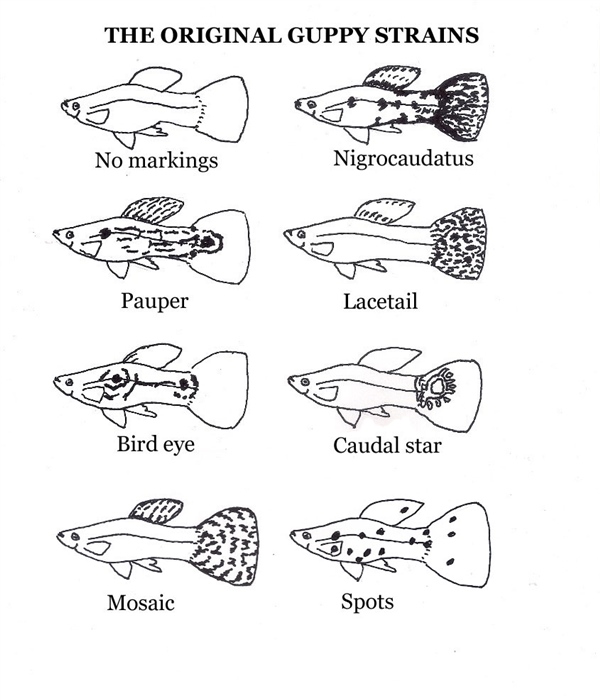
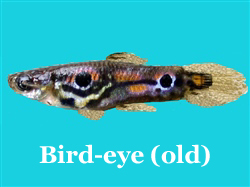
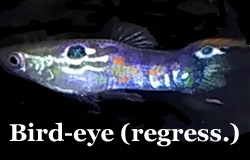
So all those gup strains bred by humans do NOT correspond to any genetic -biological necessity. They correspond to standards designed by guppy clubs and to human aspirations. If there were not these regular exhibitions of guppy clubs with prizes to be won, the question is to what extent new gup strains would be bred. Monochrome guppies also intrinsically violate the richness of color of the fish: from a human point of view, they may be admirable breeding results of dedication and expertise, but from a biology-genetic point of view, they are actually totally uninteresting. The same can be said of the recessive pigmentations of blond, blue and albino, and of all the possible extension of fins that the guppy appears to be capable of. In nature, they do not provide any logistical advantage in survival, on the con-trary. Therefore, there is the need to create a new table, with those genetic traits and gup strains that DO matter.
Those patterns that do make a difference in genetics, and have given rise to different gup strains, can thus essentially be traced back to 8 basic pat-terns that are present in the wild gup , and have emerged by selection during the first cultures. These SAME patterns can be seen reappearing in an almost "magical way" when guppies are released into the wild . The "exaggerated" fancy guppy characteristics are seen in such a population gradually disappear; this is called regression towards the wild form. And at the same time the natural wild-shape drawings and patterns reappear.
In the drawing above I have drawn these basic strains. Firstly, there is a spotting pattern in the caudal fin that subsequently resulted in the mosaic tail drawing. Followed by the unmarqued pattern on the body and its op-posite with spots on the body. There is the stripe and spot pattern on the body, which later gave birth to the Wiener Emerald, and is recorded as the old strain pauper . There is the bird-eye with such a drawing on the tail root or on the body. There is the lace tail , which upon further traversing produces the filigree motif. There is the important nigrocaudatus with black marked posterior body, which was at the base of the half-black. And last but not least, there is also the caudal star at the tail-caudal fin. These 8 basic strains form the gene pool from which all guppy strains were subse-quently bred ( Line (1) on the genealogical tree below).
The COLOR as such plays less of a role here, because the different colors can always appear mixed , at their preferred locations , as I have emphasized in my previous articles. So, strictly speaking, the blue, red, white, yellow, green, or purple tuxedo are not a new tribe, but rather color variations of the tuxedo strain. And why they want to breed single-colored guppies if there is such a beautiful color combinations , will always remain a mystery to me. It would be better to give prizes to the guppies with the most beautiful color harmony. Seeing a cultivated product as a painting rather than something that is judged on "standards".


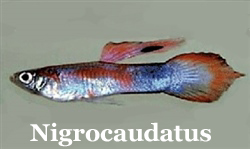


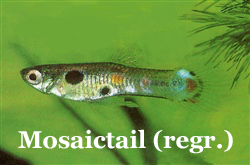

In this way one can draw up a well-arranged genealogical family tree of the guppy, on which not only all natural strains that can be found in feral guppies occur, but also all those which are creations of humans. And those fancy guppy strains bred for 100 years can be placed in their natural line of descent.
These (man-made) hybridization products can be found on line (2) . Particularly in direct descent: the mosaic triangles, the solid colored (blue, red, multicolor, ...) triangles, the caudal star - maybe an outside line for you, but I'll get to that later in detail back-, the snakeskin, and the half-black or tuxedo. These strains in (2) can be called the modern guppy strains (since 1960), and are also the basis of all further strains that were later bred from them (3 and 4) .
An important argument for this format - I can't emphasize it enough - is provided by the proofs of it "in the opposite direction": when guppies are released back in the wild, a regression to these 8 basic patterns occurs in the population. This is a phenomenon that is well known to guppy bree-ders, but in which they show no interest at all, bacause a regression is going in a diametrically opposed direction than that which they intend to breed. But in wild populations where guppies are even for the first time released, one sees these "old" patterns, which our grandparents saw, literally reappear. I have listed a few below on the left: the "old-fashioned" traditions, and the "new" appearances of them.
The caudal star is generally not considered as a guppy strain. Rather as an "artifact" of one particular strain. Philip Shaddock says this in his opus Guppy Color Strains : "The best examples of the Vienna Emerald also have a" Peacock Butterfly "( a Peacock's Eye) - a black eye with an irides-cent rim - on their caudal fin (page 225). " And continues: "The trunk gets its name from the intense green, metallic color at the base of its caudal fin, from where it continues over the rest of the body. It is called the" Emerald Green Iridescent ", for short EGI. (p126) ". I cannot agree with that, and I have 3 important arguments for it.
One: the name "Vienna Emerald" is the English name for a gup strain that was originally bred and named in Ger-many as Wiener Smaragd . It had the properties of a green-blue ground color and those typical "meander-shaped" drawings on the body. This strain was originally also a triangle. There was no question of that star on the caudal root at that time. Later these were crossed back on double swords, and the strain was further bred under the new name Vienna Emerald mainly as double swords.
Two: the blue-green star was brought in by these double swords. But even there you can see specimens with and without this star.
Three: that caudal star is a common feature within these double swords, and to the extent that this feature is more fundamental than the "double swords" feature. This is proven by the backcrosses of the Japanese breeder Kenjiro Tanaka with his Ginga Kinubali : these gingas show characteris-tics of the Wiener Smaragd and the lace-tail, and have a caudal star in high-frequency (but in white, yellow, green, green, yellow, blue or red). That is why lace tail and caudal star in the genealogical family tree also lie side by side for me: the "primal guppies" often show mixed forms of both. And by the way, the caudal star can occur as the base type of 1 in all the different derived tribes in 2, 3 and 4 : below left 3 examples of it in the variegated triangle Grass, a King Cobra and a Snakeskin.
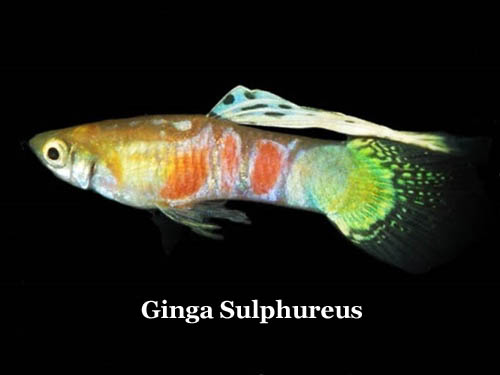
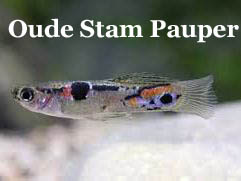

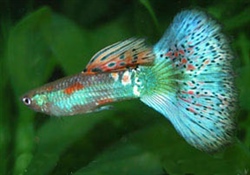

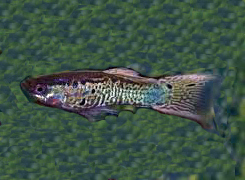

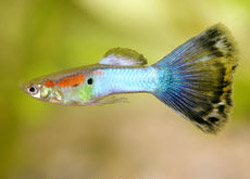
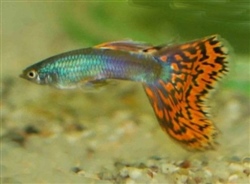
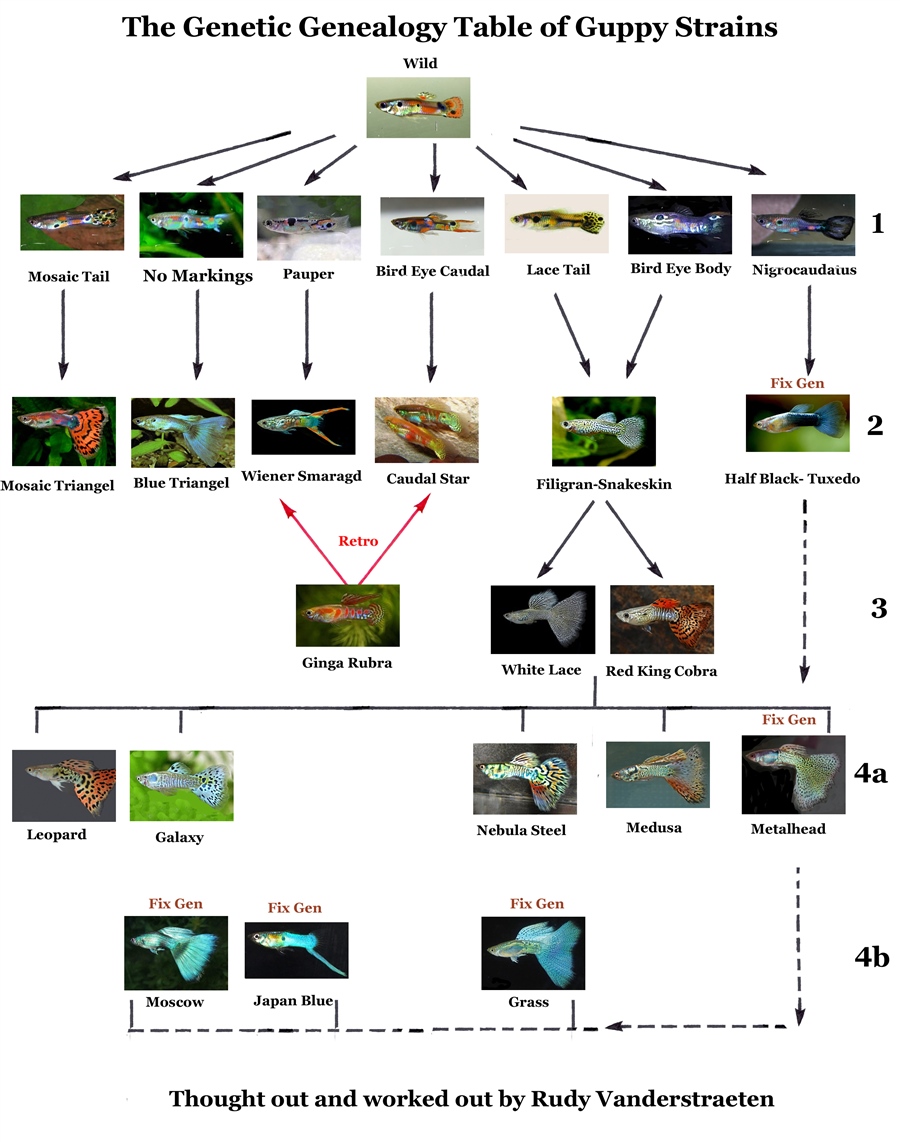
Time to pay attention to the strains that were bred from the 8 basic strains in 2 . But I'm not going to do this in the way people have done that so far: giving and enumerating names doesn't really give insight and overview in how these strains relate to each other. Originally I wanted to show all the gup strains in circles: that would make drawing the arrows easier to draw relationships, but that would make the overall picture rather complicated. That is why I chose to put two lines in the genetic family tree: 4a and 4b . It is no coincidence that the two newest "discoveries" of the last decades, and which are actually the basis of all "modern" gup strains that are "derived" from it: the Snakeskin and the Half Black . Leopard, Galaxy, Nebula Steel, Medusa and Metalhead are bred products of the Snakeskin strain. Vertically indicated is the other strain in 2 with which the culture was performed. Metalhead, Moscow, Japan Blue and Grass are breeding products of the Half Black strain. Their location already vertically represents the other strain in 2 with which they were bred. This layout makes everything clear and distinct. Of course, it does not reflect the atten-tion, care and time required to breed such a new strain.
The attentive viewer will have noted that above some of the photos is the note Fix Gen : this stands for a trait due to a fixed piece of genome . As a result of a crossing over at the chromosome union, a piece was "switched places" and therefore the corresponding place was switched by that piece. The "blessing" of this for growers is that this trait is passed on unchanged and permanently from generation to generation. The "plague" of it is that one remains saddled with a fixed pattern within which one can no longer share varia-tions. Once Half Black in introduced for example, then one is sticked for ever with Half Black. The same phenomenon with regard to Metalhead, Moscow, Japan Blue and Grass. One is obliged to breed varia-tions OUTSIDE that pattern: Half Black with red, white, yellow or blue fore body and tail fin for example. That is the price that one pays to adopt fixed patterns as the primary requirement and criterion. The Gingas and the Snakeskins allow for much more variability. A not unimportant consequence of this is that one cannot longer get those fixed pieces genome out of his culture, and that in the long run one gets ugly guppies that are, as it were, built up from all kinds of puzzle pieces. I have placed 3 examples here on the left, to show how far one has strayed in that way from "fancy" guppies with harmonious richness of colors and shades. And with this I can conclude my plea for the breeding of beautiful guppies in a shape and color palette that is closer to their natural appea-rance.